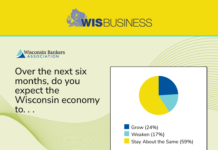A new report on the state’s tax incremental financing program finds more than $4 of new tax base is created for every $1 invested in a Wisconsin TIF district.
The report was created by the Wisconsin Realtors Association and the state chapter of the Commercial Real Estate Development Association to highlight the program. The groups argue that “enhancing the flexibility” of the state’s TIF statute will make Wisconsin more competitive for talent and investment.
“In order to attract development and jobs to Wisconsin, we must continue to provide the kind of investment opportunities that other states simply do not have,” said Tom Larson, WRA’s senior vice president of legal and public affairs. “This report shows that our state is in a unique position to be a haven for economic development if the proper tools are in place.”
TIF helps cover economic development costs in a designated tax increment district using the increased property tax revenue associated with higher property values — or tax increment — within the district. Smaller cities and villages in the state tend to use TIF more, though Milwaukee has significantly upped its use of the funding tool over the past two decades.
Wisconsin’s TIF program was created in 1975 with a goal of funding improvements on blighted land but has since been used more widely as an economic development tool. Supporters say it enables greater economic growth by incentivizing developers and municipalities to work together on projects, while others claim it’s grown well beyond its original intent.
One notable critic is Sen. Duey Stroebel, R-Saukville, a realtor who has bashed the program, questioning why taxpayers should help pay for new real estate development.
“While some detractors are attempting to limit the benefits that this tool gives our state, the report clearly shows the dramatic economic impact TIF makes in our communities,” said Jim Villa, CEO of the state’s NAIOP chapter.
The report shows the return on investment for TIF districts in the state was 427 percent between 2009 and 2016. ROI for TIF districts fluctuated during those years from a high of 873 percent in 2010, to a low of 264 percent in 2013.
During the same period, TIF districts that closed had been open for about 16 years on average. Depending on the type of TIF district, the max life of the district can range from around 20 to 27 years, the report shows. Gov. Tony Evers yesterday signed a bill that extends the length of two tax incremental districts in Lake Delton.
In the report, WRA and NAIOP highlight seven TIF districts across the state that have directly created thousands of jobs to underline their claims about the economic impact of the financing tool. One in West Allis has led to 2,300 new direct jobs and 3,200 indirect jobs, for a total of more than 5,500 jobs. The annual income taxes on direct jobs is around $13.7 million, and the district has generated a tax increment of more than $49 million since the base year of 2004.
In another TIF district in Chilton, about 450 total jobs have been created and $1.2 million in income taxes are collected each year. Since the base year of 1992, more than $35 million in tax increment has been created.
“While these communities are only a sampling of TIDs from across the state, their results demonstrate that TIF can have a significant impact on a local economy through job creation,” report authors wrote.
Without the influence of TIF in the state, the report claims the state would have to budget an additional $510 million per year to replace the revenue created by TIF. They also note Wisconsin’s TIF program doesn’t have some of the same restrictions as other states, arguing that flexibility enables greater economic development impacts.
See the full report: http://aaaed961-2523-4efa-9c25-1d9686d120b4.filesusr.com/ugd/629139_64e9b8c0b4d44f0d84e4fe406eca06a3.pdf
See an earlier story on TIF: http://www.wisbusiness.com/2019/new-report-examines-tax-incremental-financing/
–By Alex Moe
WisBusiness.com






